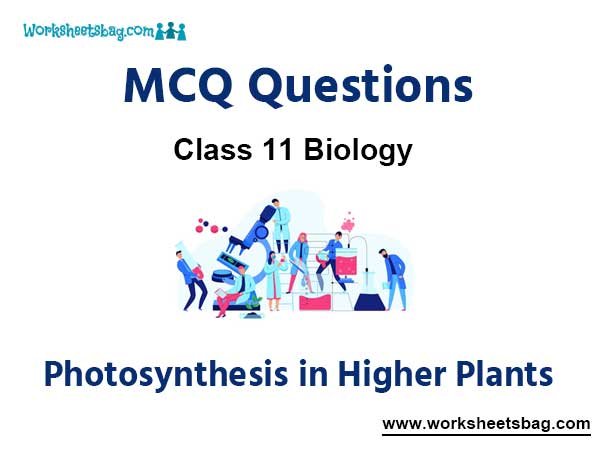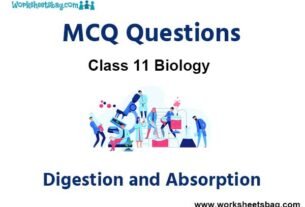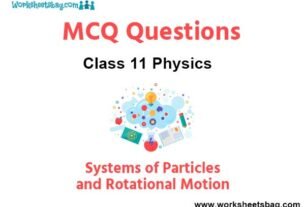Please refer to Photosynthesis in Higher Plants MCQ Questions Class 11 Biology below. These MCQ questions for Class 11 Biology with answers have been designed as per the latest NCERT, CBSE books, and syllabus issued for the current academic year. These objective questions for Photosynthesis in Higher Plants will help you to prepare for the exams and get more marks.
Photosynthesis in Higher Plants MCQ Questions Class 11 Biology
Please see solved MCQ Questions for Photosynthesis in Higher Plants in Class 11 Biology. All questions and answers have been prepared by expert faculty of standard 11 based on the latest examination guidelines.
MCQ Questions Class 11 Biology Photosynthesis in Higher Plants
Question- By looking at which internal structure of a plant can you tell whether a plant is C3 or C4?
(a) Kranz anatomy
(b) Distribution of mesophyll cells
(c) Bundle sheath cells only
(d) Both (a) and (b)
Answer
D
Question- Half leaf experiment proves that
(a) light is essential for photosynthesis.
(b) CO2 is essential for photosynthesis.
(c) O2 releases during photosynthesis.
(d) chlorophyll is essential for photosynthesis.
Answer
B
Question- Which of the following statement is incorrect ?
(a) H2S, not H2O, is involved in photosynthesis of purple sulphur bacteria.
(b) Light and dark reactions are stopped in the absence of light.
(c) Calvin cycle occurs in the grana of chloroplast.
(d) ATP is produced during light reaction via chemiosmosis.
Answer
C
Question- In Calvin cycle, RuBisCO incorporates CO2 into ribulose, 1, 5-bisphosphate which rapidly splits into
(a) 2 molecules of 3-PGA
(b) 2 molecules of 2-PGA
(c) 3 molecules of 3-PGA
(d) 3 molecules of 2-PGA
Answer
A
Question- The experiment material used by Van Neil, to prove that O2 comes out from water was studied on
(a) Chlorella pyrenoidosa
(b) Cladophora
(c) purple & green sulphur bacteria
(d) blue green algae
Answer
C
Question- Which of the following statement is incorrect regarding pigments?
(a) Pigments are substances that have an ability to absorb light, at specific wavelengths.
(b) Chlorophyll b is the chief pigment associated with photosynthesis.
(c) Leaf pigments can be separated by chromatography.
(d) Accessory pigments protect chlorophyll a from photo-oxidation.
Answer
B
Question- Which one represents the correct empirical equation of photosynthesis?
(a) C6H12O6 + 6O2 → 6CO2 + 6H2O + energy
(b) C6H12O6 + 6O2 + 6H2O → 6CO2 + 12H2O + energy
Light
(c) 6CO2 + 6H2O → 6O2 + C6H12O6
Chlorophyll
Light
(d) 6CO2 + 12H2O → 6O2 + C6H12O6 + 6H2O
Chlorophyll
Answer
D
Question- What is/are the function(s) of accessory pigments?
(a) They enable a wider range of wavelength of incoming light to be utilized for photosynthesis.
(b) They absorb light and transfer the energy to reaction centre.
(c) They protect reaction centre from photo-oxidation.
(d) All of the above
Answer
D
Question- The light harvesting complex (LHC) is made up of
(a) one molecule of Chl a.
(b) very few molecules of Chl a.
(c) hundreds of pigment molecules bound to proteins.
(d) Chl a + Chl c + protein + DNA.
Answer
C
Question- Bundle sheath cells
(a) are rich in RuBisCO.
(b) are rich in PEP carboxylase.
(c) lack RuBisCO.
(d) lack both RuBisCO and PEP carboxylase.
Answer
A
Question- Which one of the following is incorrect about the activities associated with PS – I and PS – II in non-cyclic photophosphorylation ?
(a) Water is oxidised in PS – II, but not in PS – I.
(b) Photons (light) are needed to activate both PS – I and PS – II.
(c) Photolysis of water, formation of ATP + NADPH + H occur.
(d) Production of NADPH + H+ is associated with PS – II, but not with PS – I.
Answer
D
Question- An energy diagram for the transfer of electrons in the light reactions of photosynthesis in plants is
(a) cyclic photo-phosphorylation
(b) Z-band
(c) Z-Scheme
(d) non-cyclic photo-phosphorylation
Answer
C
Question- One of the earliest experiments on photosynthesis was done in 1770 by Joseph Priestley. He demonstrated that
(a) sun is the ultimate source of energy.
(b) water is essential for life.
(c) plants & animals “restore” the air for each other.
(d) chlorophyll captures light energy.
Answer
C
Question- Correct equation that represents the photolysis of water is
(a) 2H2O → 4H+ + O2 + 4e–
(b) H2O → 4H+ + O2 + 4e–
(c) 4H2O → 4H+ + O2 + 4e–
(d) 2H2O → 4H+ + 2O2 + 2e–
Answer
A
Question- The chemiosmotic mechanism mediates
(a) ATP synthesis.
(b) splitting of water.
(c) reduction of NADP+.
(d) flow of electrons from PS – II to PS – I
Answer
A
Question- How can we separate leaf pigments of any green plant?
(a) Column chromatography
(b) Paper chromatography
(c) Electrophoresis
(d) Radio-isotopes
Answer
B
Question- In photosynthesis, protons accumulate in the
(a) inner membrane space of mitochondria.
(b) matrix of mitochondria.
(c) lumen of thylakoid.
(d) stroma of thylakoid.
Answer
C
Question- Electrons are picked up by an electron acceptor which passes them to an electron transport system consisting of
(a) phytochromes
(b) cytochromes
(c) Z-scheme
(d) redox potential scale
Answer
B
Question- In PS-I, the reaction centre Chl a has absorption maxima at _____________, while in PS-II the reaction centre Chl a has absorption maxima at ___________.
(a) P680, P700
(b) P700, P680
(c) P800, P600
(d) P700, P900
Answer
B
21. No. of carbons in the primary CO2 fixation product of C4 plant is
(a) 2
(b) 3
(c) 4
(d) 5
Answer
C
Question- Which of the following statement is incorrect?
(a) Photosystem-I receives electrons from photosystem-II.
(b) Photosystem-II receives electrons from photolytic dissociation of water.
(c) Formation of NADPH is associated with photosystem -II.
(d) Reaction centre of photosystem I is P700.
Answer
A
Question- The total requirement of ATP & NADPH for each molecule of CO2 fixed & reduced in photosynthesis in the Calvin cycle is
(a) 2 ATP & 2 NADPH
(b) 2 ATP & 3 NADPH
(c) 3 ATP & 2 NADPH
(d) 4 ATP & 3 NADPH
Answer
C
Question- Which among the following sentence is incorrect about light reaction?
(a) It is also known as ‘photochemical’ phase.
(b) It includes light absorption, water splitting, oxygen release, and the formation of high-energy chemical intermediates.
(c) Reaction centre consist of single molecule of chl a but 2 molecules of chl b.
(d) The pigments are organised into two discrete photochemical light harvesting complexes (LHC) within PS – I and PS – II.
Answer
C
Question- Contribution of Ingen-Housz in elucidation of process of photosynthesis is that
(a) only green parts of plants exposed to light can convert foul air (CO2) into pure air (O2).
(b) green plants convert light energy into chemical energy
(c) plants have the capacity to purify foul air.
(d) sunlight is the ultimate source of energy for plants and animals.
Answer
A
Question- In a plant cell, which of the following pigments participates directly in the light reactions of photosynthesis?
(a) Chlorophyll a
(b) Chlorophyll b
(c) Chlorophyll d
(d) Carotenoids
Answer
A
Question- Photosynthesis is important because
(a) it is the primary source of food on earth.
(b) it is responsible for release of O2 into the atmosphere by green plants.
(c) it is responsible for release of water vapour into the atmosphere.
(d) both (a) and (b)
Answer
D
Question- Fixation of CO2 molecule through Hatch and Slack pathway requires an enzyme called _________ .
(a) PEPcase
(b) RuBisCO
(c) RuBP carboxylase
(d) oxygenase
Answer
A
Question- Site of photosynthesis in C4 plant is
(a) mesophyll cells
(b) bundle sheath cells
(c) Both (a) and (b)
(d) Cytosol
Answer
C
Question- In the leaves of C4 plants, malic acid formation during CO2 fixation occurs in the cells of
(a) bundle sheath
(b) phloem
(c) epidermis
(d) mesophyll
Answer
D
Question- Which one of the following statement is incorrect in relation to photorespiration?
(a) It is a characteristic of C3 plants.
(b) The RuBP binds with O2 to form one molecule of phosphoglycerate and phosphoglycolate.
(c) There is synthesis of ATP or NADPH.
(d) It occurs in daytime only.
Answer
C
Question- In C4 plants, the process by which C4 acid is converted into C3 acid in the bundle sheath cell is known as
(a) carboxylation
(b) regeneration
(c) reduction
(d) decarboxylation
Answer
D
Question- Splitting of water is related with
(a) photosystem I
(b) photosystem II
(c) both (a) and (b)
(d) cyclic photo-phosphorylation
Answer
B
Question- Photorespiration is a wasteful process because
(a) there is no synthesis of sugars.
(b) there is no synthesis of ATP or NADPH.
(c) there is no synthesis of phosphoglycerate.
(d) both (a) and (b)
Answer
D
Question- Chloroplast movement is influenced by
(a) light exposure
(b) dark condition
(c) atmospheric condition
(d) number of mesophyll cells
Answer
A
Question- Photorespiration
(a) occurs because oxygen rather than carbon dioxide links to the rubisco enzyme in the Calvin cycle.
(b) occurs more in C4 than in C3 plants under identical conditions.
(c) describes the uptake of CO2 & the release of oxygen in chloroplasts.
(d) All of the above
Answer
A
Question- Which of the following statement best support the fact that photorespiration commonly occurs in C3 plants?
(a) C3 plants don’t possess Kranz anatomy.
(b) C3 plants have usually high CO2 compensation species.
(c) C3 plants are less efficient in photosynthesis.
(d) C3 plants are characterized by RuBP oxygenase activity under high oxygen supply.
Answer
D
Question- Plant factors affecting photosynthesis include
(a) number, age, size, and orientation of leaves, mesophyll cells and chloroplast, internal CO2 conc., the amount of chlorophyll .
(b) nature of leaves, size of mesophyll cells and light.
(c) mesophyll cells, distribution and temperature.
(d) quantity of chlorophyll, size of leaves and CO2.
Answer
A
Question- The primary CO2 acceptor in C4 plant is
(a) RuBP
(b) phosphoenol pyruvate
(c) PEP carboxylase
(d) PGA
Answer
B
Question- Which of the following statement is incorrect?
(a) Site of photosynthesis is mesophyll cells of chloroplast.
(b) In Z-scheme, movement of electrons is uphill in terms of redox potential scale.
(c) In Z-scheme of photosynthesis, the electrons flow from H2O to NADP+.
(d) ATP synthesis is linked to development of a proton gradient across a membrane.
Answer
B
Question- Which is the primary CO2 fixation product in C4 plant?
(a) 3-phosphoglyceric acid
(b) Oxaloacetic acid
(c) Phosphoenol pyruvate
(d) RuBP
Answer
B
Question- Which was the first CO2 fixation product formed, in the Calvin experiment, using radioactive labelled 14C in green algal?
(a) 2-carbon organic compound
(b) 3-carbon organic compound
(c) 4-carbon organic compound
(d) 5-carbon organic compound
Answer
B
Question- Which one of the following statement correctly describes the cyclic photophosphorylation?
(a) Cyclic photophosphorylation has both PS-I and PS-II.
(b) Cyclic phosphorylation produces neither ATP nor NADPH + H+.
(c) Water is the ultimate source of e– in cyclic phosphorylation.
(d) Electrons are cycled in cyclic photophosphorylation.
Answer
D
Question- Photosynthesis is a/an
(a) physio-chemical process.
(b) physical process.
(c) chemical process.
(d) energy wasting process.
Answer
A
Question- All of the following statements are incorrect for non-cyclic electron transport system, except
(a) Electron transport between PS -II to PS-I produces ATP by substrate level phosphorylation.
(b) In PS-II, the oxidation of two water molecules produces four electrons, four proteins, & a single O2.
(c) Water is oxidized & electrons are released by PS-I.
(d) PS – II reduces NADP+ to NADPH.
Answer
B
Question- ATP synthesis, in photosynthesis involves the
(a) establishment of a protein gradient.
(b) oxidation of water.
(c) reduction of NADP+.
(d) flow of electrons.
Answer
A
Question- A process that creates an important difference between C3 & C4 plants is called____________.
(a) Calvin benson cycle
(b) photosynthesis
(c) photorespiration
(d) transpiration
Answer
C
Question- Which of the following statement(s) is/are correct about RuBisCO?
(a) It catalyzes the fixation of CO2.
(b) It has oxygenation & carboxylation both activity.
(c) It is the most abundant protein on earth.
(d) All of the above
Answer
D
Question- The light-driven synthesis of ATP & NADPH, provides energy and reducing power for the
(a) conversion of inorganic carbon into organic carbon.
(b) fixation of CO2 into trioses.
(c) for the production of sugars.
(d) all of the above.
Answer
D
Question- The principle of limiting factors was proposed by
(a) Blackman
(b) Hill
(c) Arnol
(d) Liebig
Answer
A
Question- Which of the following statements given below is incorrect ?
(a) The C4 plants respond to higher temperatures while C3 plants have a much lower temperature optimum.
(b) Tropical plants have a higher temperature optimum than the plants adapted to temperate climates.
(c) Some C3 plants are allowed to grow in CO2 enriched atmosphere that leads to higher yields.
(d) Water stress causes the stomata to remain open hence enhancing the CO2 availability.
Answer
D



